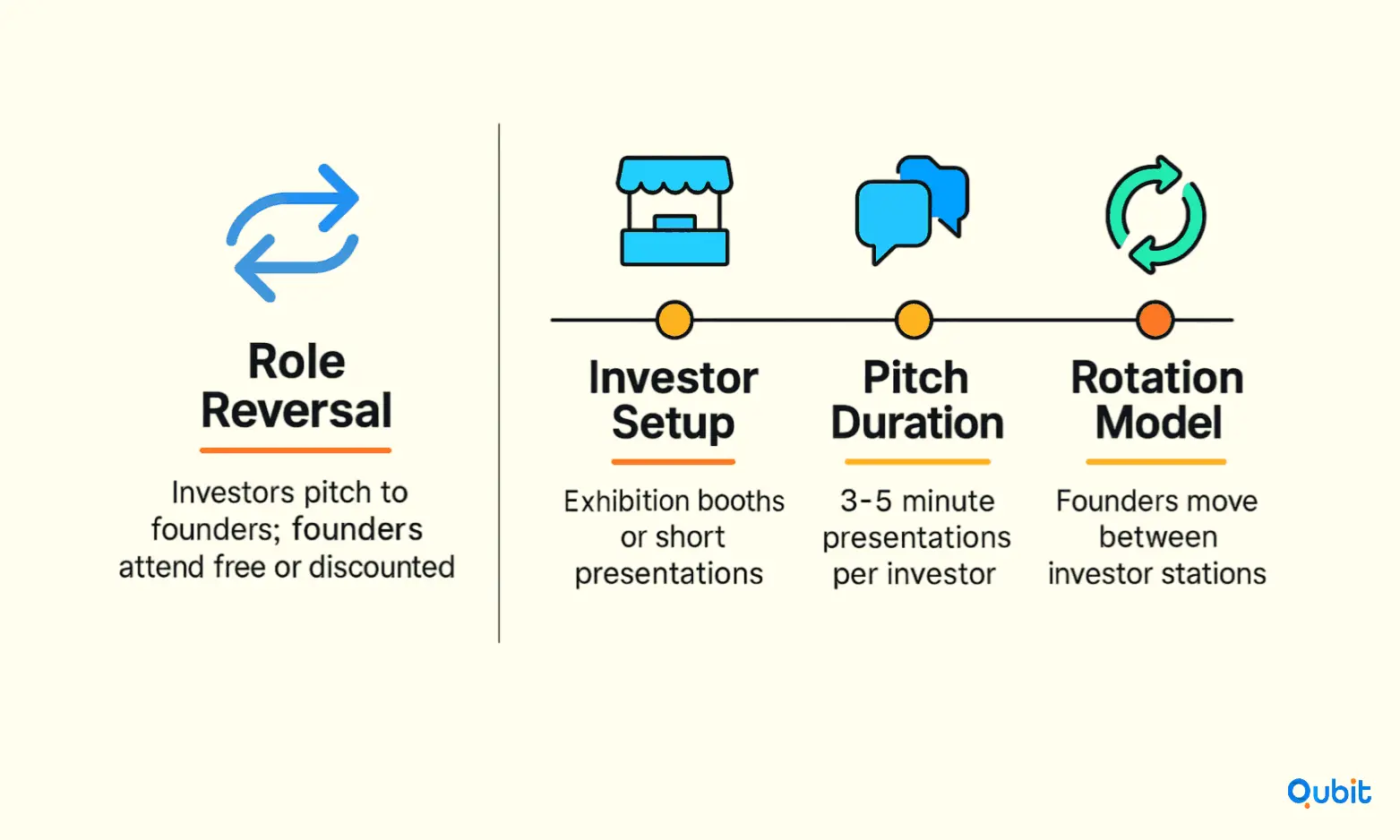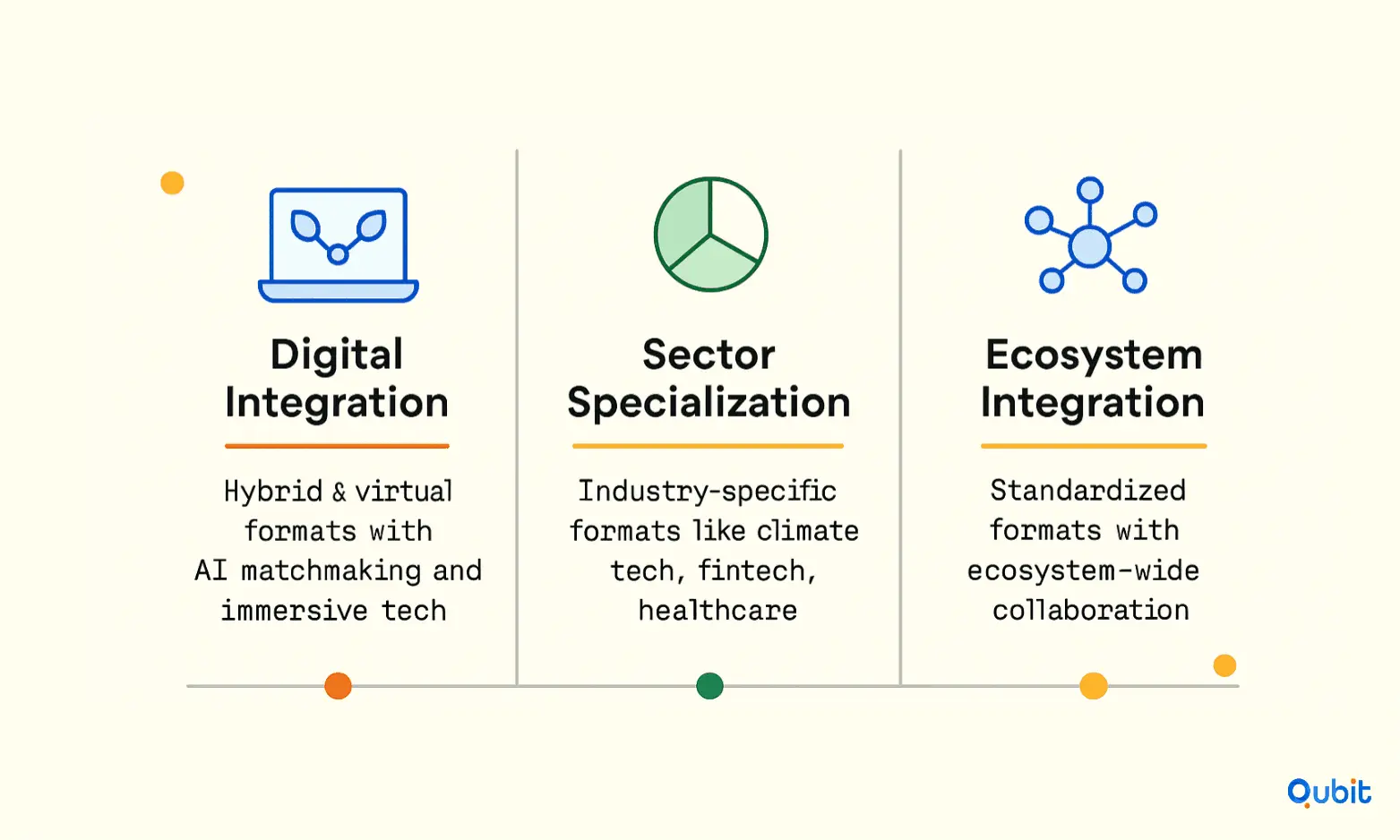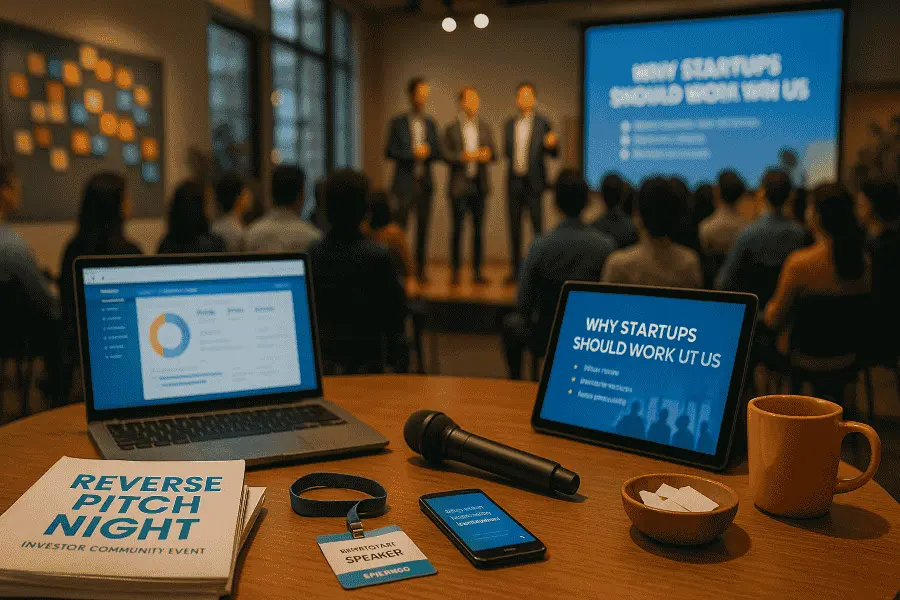Reverse pitch events are changing how founders and investors meet. Instead of startups pitching for attention, investors and corporates take the stage to win over founders. This flips the usual power dynamic and turns capital providers into active sellers of their value, not just buyers of equity.
Momentum for this format is growing fast. In 2024, reverse pitch challenges headlined major healthcare startup events, with new reverse pitch parties announced in cities like Leeds, London, and Manchester. This global expansion signals that the model is moving into the mainstream and giving founders more choice in who they work with.
Reverse pitch events also act as community builders. They create spaces where transparency, mutual respect, and clear value alignment matter more than one sided selection. As startup ecosystems look for more inclusive and founder friendly engagement models, reverse pitching is becoming a key strategy for building stronger, better connected communities that benefit everyone involved.
Understanding the Reverse Pitch Events Model
A reverse pitch event flips the usual script. Instead of founders pitching for capital, investors pitch their value to founders. This lets entrepreneurs compare options and choose the investors who best match their needs.

Core Mechanics And Structure
Reverse pitch events are built on a clear role reversal. Investors and ecosystem players pitch their value propositions to founders and entrepreneurs, not the other way around.
The structure usually reinforces that shift:
- Investors pay participation fees to join
- Entrepreneurs get free or discounted access
That pricing alone signals an inverted power dynamic.
On the day, investors either host exhibition style booths or deliver short, structured presentations, often three to five minutes long, followed by Q&A. The flow often feels like speed dating. Founders rotate between investor stations and ask direct questions about:
- Investment criteria
- Portfolio support and networks
- Track record
- Typical terms and expectations
This format lets founders evaluate several potential partners quickly while keeping control over who they engage with next. It turns investor selection into an active, informed choice rather than a one way audition. To gain a broader contextual perspective, explore how to do startup outreach for investors, which provides a foundational backdrop to this detailed guide.
Key Differentiators from Traditional Formats
The reverse pitch model introduces several critical differentiators that enhance ecosystem engagement:
- Information Asymmetry Correction: Traditional pitch events often leave entrepreneurs with limited insights into investor motivations, decision-making processes, and value-add capabilities. Reverse pitches force transparency by requiring investors to publicly articulate their investment theses, portfolio strategies, and founder support mechanisms.
- Founder Empowerment: Rather than positioning entrepreneurs as supplicants seeking capital, reverse pitches establish founders as evaluators making informed partnership decisions. This shift promotes more balanced negotiations and healthier long-term relationships.
- Efficiency Enhancement: Traditional networking often involves random connections and misaligned conversations. Reverse pitches create structured environments where compatibility assessment happens upfront, leading to more productive follow-up discussions.
Benefits of Reverse Pitch Events for Ecosystem Development
Reverse pitch events have become essential for building trust and openness in startup communities. Healthcare is a prime example of transparent collaboration. At the 2024 Reverse Pitch Challenge Finale, investors publicized their partnership criteria before startup founders. This practice directly increases trust and enables better decision-making.
1. Transparency and Trust Building
Reverse pitch events significantly enhance ecosystem transparency by compelling investors to publicly share their operational philosophies, success metrics, and portfolio company experiences. This transparency builds trust within startup communities by removing information asymmetries that historically favored investors. When venture capitalists and angel investors must articulate their value propositions publicly, entrepreneurs gain crucial insights for making informed partnership decisions.
The format encourages honest dialogue about investment terms, decision-making timelines, and post-investment support structures. This openness helps establish realistic expectations and reduces the likelihood of misaligned partnerships that can damage both investor reputations and founder experiences within tight-knit startup communities.
2. Community Network Strengthening
These events serve as powerful networking catalysts, bringing together diverse ecosystem participants including founders, investors, accelerators, corporate innovation teams, and support organizations. Unlike traditional conferences where networking happens peripherally, reverse pitch events center relationship-building as the primary objective.
The structured interaction format ensures meaningful connections by matching participants based on relevant criteria such as industry focus, investment stage, or geographic preferences. This targeted matching increases the likelihood of productive long-term relationships while reducing networking fatigue common at traditional events.
4. Knowledge Transfer and Learning
Reverse pitch events facilitate valuable knowledge transfer between experienced investors and emerging entrepreneurs. When investors present their investment theses and portfolio insights, they inadvertently provide educational content about market trends, successful business models, and common startup pitfalls.
Entrepreneurs benefit from hearing diverse investor perspectives on similar market opportunities, helping them refine their own strategic thinking. Additionally, investors gain insights into current founder concerns, market dynamics, and emerging technologies through direct dialogue with entrepreneurial talent.
Implementation Strategies and Best Practices
Putting on a reverse pitch event is not just about flipping the mic. It needs clear design, tight curation, and the right follow up to actually deliver value for both founders and investors.
1.Event Planning and Structure
Successful reverse pitch events require careful planning and structured execution to maximize ecosystem value. Event organizers should begin with clear objective definition, determining whether the primary goal is fundraising facilitation, partnership development, or general ecosystem building.
Pre-Event Preparation:
- Investor application and vetting processes to ensure quality and relevance
- Entrepreneur registration with startup stage and industry categorization
- Pre-event matchmaking surveys to optimize interaction scheduling
- Educational resources providing guidance on effective evaluation criteria
Event Day Structure:
- Opening presentations explaining format and expectations
- Structured pitch rounds with standardized timing (typically 4-5 minutes pitch + 2-3 minutes Q&A)
- Informal networking sessions between structured rounds
- Closing sessions for contact information exchange and next steps planning
For businesses looking to refine their PR strategies, exploring effective outreach channels for investors can provide actionable insights that complement these methods.
2. Participant Selection and Quality Control
Maintaining high participant quality requires robust selection criteria for both investors and entrepreneurs. For investors, organizers should evaluate track record, investment activity level, geographic relevance, and value-add capabilities beyond capital. Preference should be given to active investors with recent deal flow (a steady stream of investment opportunities) and demonstrated founder support experience.
Entrepreneur selection should consider startup stage alignment with participating investors, innovation level, and growth potential. Including a diverse mix of industries, business models, and founder backgrounds enriches the learning environment for all participants while expanding potential matching opportunities.
Quality control mechanisms include:
- Reference checks for investor participants
- Startup verification through pitch deck reviews or brief screening calls
- Post-event feedback collection for continuous improvement
- Community guidelines enforcement to maintain professional standards
3. Founder Preparation Strategies for Reverse Pitch Events
- Research participating investors and organizations to identify those whose priorities align with your startup’s mission and growth stage.
- Prepare concise questions that probe investor motivations, value-add capabilities, and post-investment support structures for meaningful dialogue.
- Develop a clear narrative of your startup’s needs and goals to evaluate which investor offerings best fit your strategic roadmap.
- Leverage event-provided coaching or virtual exhibit tools to refine your presentation and maximize engagement opportunities.
- Follow up promptly with relevant investors after the event to build relationships and clarify potential partnership pathways.
4. Risks and Mitigation in Reverse Pitch Events
Building on participant selection, organizers should anticipate and address potential risks that can undermine event outcomes. Common pitfalls include mismatched expectations between founders and investors, insufficient participant preparation, and lack of structured follow-up. Proactive communication, clear event guidelines, and post-event feedback mechanisms help mitigate these risks and sustain long-term ecosystem value.
Format Variations and Customization
Format customization is clear in 2024. The Shibuya reverse pitch event engages corporates, public sector leaders, and startups in a tailored collaboration session. This model demonstrates flexible alignment with regional and sector priorities.
Reverse pitch events can be adapted to specific ecosystem needs through various format modifications:
- Corporate Reverse Pitches: Large corporations present innovation challenges and partnership opportunities to startup communities, fostering collaboration around specific business problems.
- Accelerator Showcases: Multiple accelerator programs pitch their value propositions to founders, helping entrepreneurs identify the most suitable support programs.
- Government Innovation Sessions: Public sector organizations present policy challenges and procurement opportunities, encouraging civic technology entrepreneurship.
Comparing Reverse Pitch Formats by Sector and Engagement
Case Studies and Success Stories
Reverse pitch formats are already proving their value in practice. Sector specific programs in areas like healthcare and fintech report higher match quality between founders and investors, with more follow on meetings and faster pilot decisions compared to standard demo days.
Local ecosystems that adopted recurring reverse pitch nights in hubs like secondary cities have seen tighter investor–founder networks, more first cheques written locally, and higher founder satisfaction scores with the fundraising process, showing that format design can genuinely shift power dynamics and outcomes.
European Ecosystem Development
The European startup ecosystem has embraced reverse pitch events as a key community building tool, with notable success stories across multiple markets. Portugal's ScaleUp Porto implemented a successful reverse pitch series featuring prominent investors including Rita Branco from 3xP Global, Bernardo Pequito from Beta Capital, and Sara Mendes from SOGRAPE Ventures. The events created significant networking value while providing entrepreneurs direct access to investment decision-makers.
Austria's Startup Grind chapters have pioneered reverse pitch formats specifically designed for ecosystem development, featuring international investor delegations and creating cross-border partnership opportunities. These events have contributed to increased investor visibility in Central European markets while providing local entrepreneurs exposure to international funding sources.
Government and Corporate Engagement
The UK's Department for Work and Pensions and Ministry of Justice successfully implemented reverse pitch events across Leeds, London, and Manchester, engaging 34 small businesses in collaborative problem-solving initiatives. These events demonstrated how government organizations can leverage reverse pitching to access innovative solutions while supporting startup ecosystem development.
Singapore's SGInnovate has established a comprehensive reverse pitch series focusing on advanced manufacturing and circular economy challenges. These events connect global corporations with local startups, fostering innovation partnerships while strengthening Singapore's position as a regional innovation hub.
Regional Ecosystem Impact
Austin, Texas developed the innovative [RE]verse Pitch Competition, transforming local waste challenges into entrepreneurial opportunities. The program successfully created social enterprises including Terra Helmets and LoFi Recycling Systems, demonstrating how reverse pitching can address community challenges while fostering startup development.
Vermont's startup ecosystem has utilized reverse pitch events to strengthen connections between local founders and regional investors. These events have contributed to increased funding availability for Vermont startups while helping investors identify high-quality regional opportunities previously overlooked.
Measuring Impact and ROI
Measuring the impact of reverse pitch events starts with clear goals. Decide upfront what you want to move: better founder–investor matches, stronger pipelines, or deeper community links. Then track simple, concrete indicators such as:
- Number of follow up meetings booked within 30 days
- Intros that convert into term sheets, pilots, or partnerships
- Diversity of founders and investors attending and engaging
- Repeat participation rates on both sides
Go beyond vanity metrics like total RSVPs. Ask founders and investors for short, structured feedback on quality:
1. Quantitative Metrics
Successful reverse pitch events generate measurable outcomes that demonstrate ecosystem value. Key performance indicators include partnership formation rates, follow-up meeting frequencies, investment deal flow, and participant satisfaction scores.
Event organizers should track:
- Number of investor-entrepreneur connections made
- Percentage of connections resulting in follow-up meetings
- Investment deals originated from events (tracked over 6-12 month periods)
- Corporate partnership agreements established
- Participant Net Promoter Scores and retention rates for recurring events
2. Qualitative Assessment
Beyond numerical metrics, reverse pitch events generate qualitative benefits that strengthen ecosystem foundations. These include increased investor visibility within startup communities, enhanced founder confidence in partnership negotiations, and improved market transparency through public information sharing.
Qualitative indicators encompass:
- Founder feedback on investor accessibility and transparency
- Investor reports on deal quality and entrepreneur preparedness improvements
- Community stakeholder observations of increased collaboration
- Media coverage and ecosystem recognition improvements
- Long-term relationship quality assessments through participant surveys
3. Long-term Ecosystem Health
The ultimate measure of reverse pitch event success lies in long-term ecosystem health improvements. Healthy ecosystems exhibit increased deal flow, higher success rates, stronger founder-investor relationships, and greater overall innovation output.
Longitudinal studies should examine:
- Ecosystem fundraising volumes and success rates over time
- Startup survival and growth rates among event participants
- Investor satisfaction with local deal quality and founder relationships
- Community trust levels and reputation improvements
- Geographic retention rates for both startups and investors
Future Evolution and Trends

1. Digital Integration and Virtual Formats
The evolution toward hybrid and virtual reverse pitch events has expanded accessibility while maintaining relationship-building effectiveness. Digital platforms enable geographic expansion, allowing investors from major hubs to engage with entrepreneurs in emerging ecosystems.
Advanced matchmaking algorithms and AI-powered compatibility assessment tools are enhancing participant pairing efficiency while reducing event coordination overhead. Virtual reality and immersive technologies may further enhance remote engagement quality, particularly for complex technology demonstrations and product showcases.
2. Sector-Specific Specialization
Reverse pitch events are increasingly specializing around specific industry verticals such as climate technology, healthcare innovation, or fintech development. This specialization increases relevance for participants while deepening sector-specific relationship networks.
Specialized formats include regulatory-focused events for highly regulated industries, international trade-focused sessions for export-oriented startups, and impact-oriented events connecting mission-driven entrepreneurs with values-aligned capital sources.
3. Ecosystem Integration and Standardization
Forward-thinking startup ecosystems are integrating reverse pitch events into comprehensive ecosystem development strategies, combining them with accelerator programs, government initiatives, and corporate innovation efforts.
Standardization efforts are emerging around event formats, participant guidelines, and outcome measurement methodologies. These developments will enable more effective cross-ecosystem collaboration and knowledge sharing while maintaining local customization flexibility.
Conclusion
Reverse pitch events have emerged as transformative tools for community and ecosystem engagement. These reverse pitch events are reshaping startup-investor relationships and strengthening entrepreneurial communities worldwide.
The success of reverse pitch initiatives across diverse global markets demonstrates their adaptability and effectiveness for various ecosystem development objectives. From government innovation challenges to corporate partnership facilitation, the format proves versatile enough to address multiple stakeholder needs while consistently delivering community value.
If you're ready to connect with high-potential startups, our Startup Matchmaking service is here to help. Let us support you in building impactful partnerships that drive results.
Key Takeaways
- Reverse pitch events flip the script by making investors pitch founders, which shifts power, increases transparency, and gives founders more choice.
- The format reduces information gaps because investors must clearly explain their thesis, terms, support model, and decision timelines in public.
- Founders can compare multiple investors side by side in one session, which speeds up filtering and leads to better quality follow up meetings.
- Ecosystems that run recurring reverse pitches see tighter founder investor networks, more local first cheques, and higher satisfaction with the fundraising process.
- Careful curation, clear expectations, and structured follow up are essential, otherwise the format just becomes another noisy networking event.
- For founders, the real value is using these events as a deliberate investor selection tool, not just another place to “get exposure.”
- For investors, reverse pitch events raise the bar on clarity and actual value add, which directly affects reputation and long term deal flow.
Frequently asked Questions
What is a reverse pitch event?
A reverse pitch event lets investors and organizations pitch their value proposition to founders. This format increases transparency by revealing funding terms, portfolio strengths, and support resources. It flips the traditional power dynamic in the startup ecosystem.






